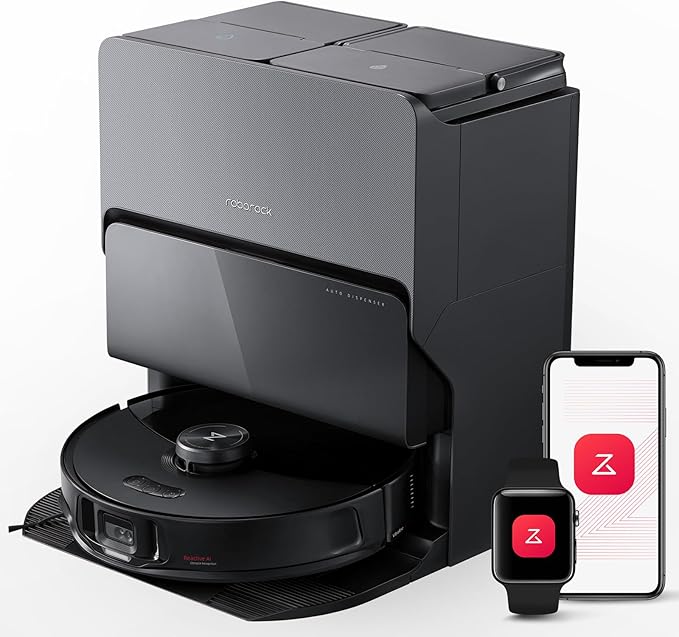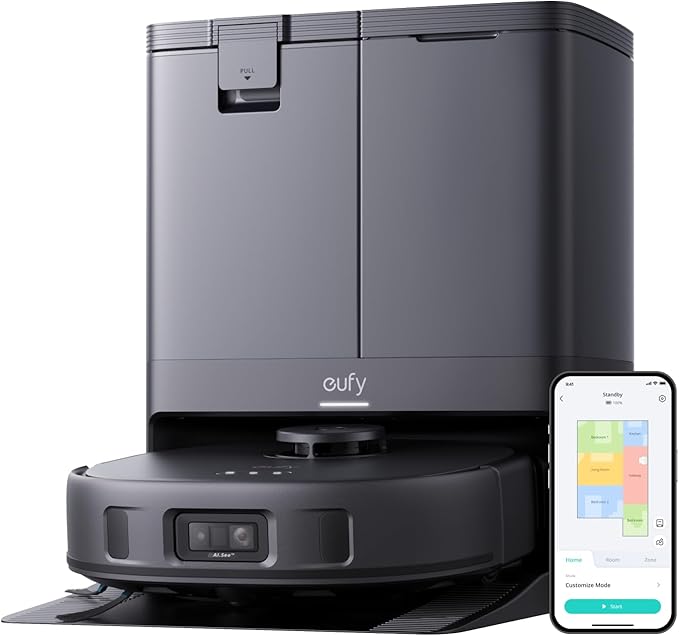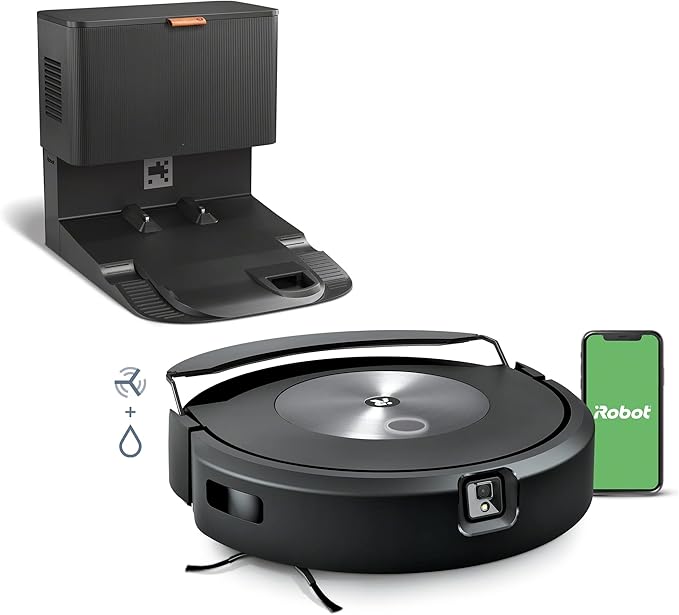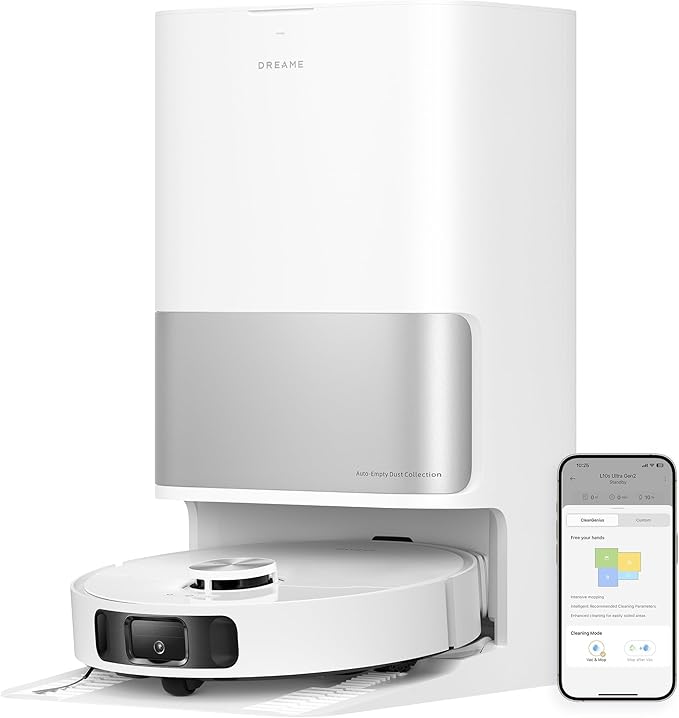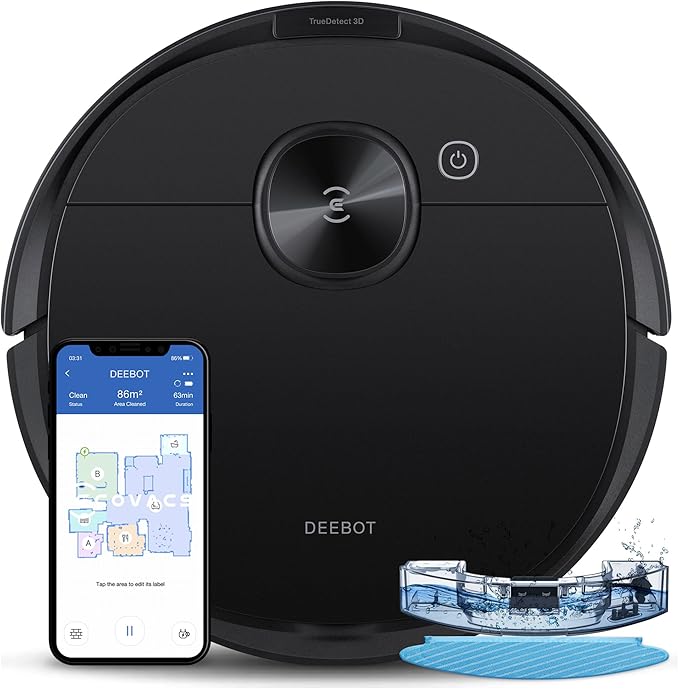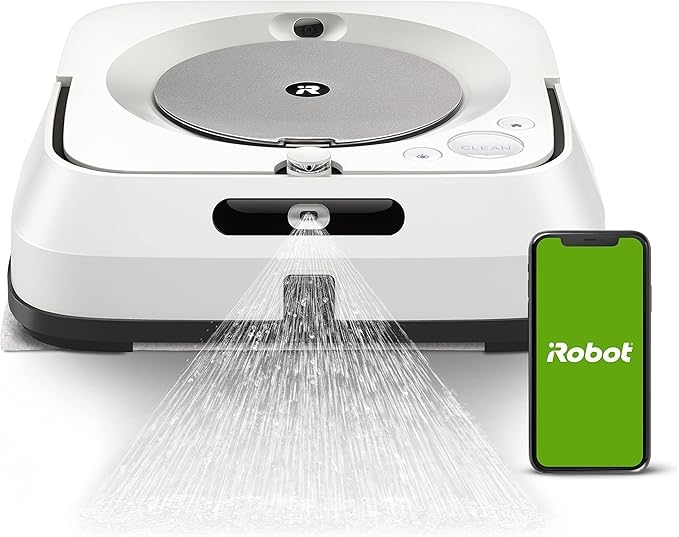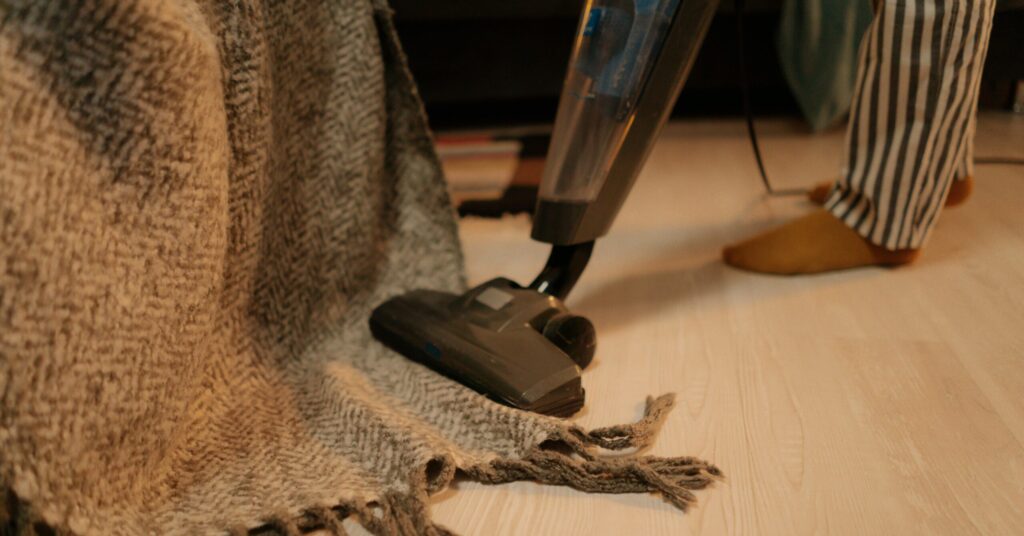We independently review everything we recommend. We may make money from the links on our site.
The Best Robot Vacuum and Mop Combos: Finding the Perfect Cleaning Assistant for Your Home

In today’s fast-paced world, maintaining a clean home often falls to the bottom of our priority list. Enter robot vacuum and mop combos—technological marvels designed to keep your floors spotless with minimal effort. These versatile devices have revolutionized home cleaning, offering an automated solution that saves time and energy. This comprehensive guide will help you navigate the complex landscape of robot vacuum and mop combos, providing expert insights to find the perfect cleaning assistant for your specific needs.
Everything We Recommend
Top Pick
The Best Overall
The Roborock S8 MaxV Ultra represents the pinnacle of current robot vacuum and mop technology, offering exceptional performance across all key metrics.
Buying Options
Budget Option
The Best Budget Option
The Eufy X10 Pro Omni offers solid performance at a budget-friendly price, making automated cleaning accessible to more households.
Buying Options
Pet Owners
The Best For Pet Owners
The iRobot Roomba Combo j7+ combines excellent hair pickup with intelligent obstacle avoidance specifically designed to handle pet-related challenges.
Buying Options
For Hard Floors
The Best For Hard Floors
The Dreame L10s Ultra Gen 2 excels at hard floor cleaning with exceptional mopping capabilities and minimal maintenance requirements.
Buying Options
Value
The Best Value
The Ecovacs Deebot N8 Pro+ delivers impressive performance and convenience at a more accessible price point than ultra-premium models.
Buying Options
For Small Spaces
The Best For Small Spaces
While technically a dedicated mop rather than a combo unit, the Braava Jet m6 deserves mention for its exceptional mopping capabilities in smaller spaces.
Buying Options
Understanding Robot Vacuum and Mop Technology
Robot vacuum and mop combos represent the convergence of advanced robotics and practical home cleaning solutions. Before diving into specific models and features, it’s important to understand how these devices actually work.
The Evolution of Floor Cleaning Automation
The journey from simple robotic vacuums to sophisticated vacuum and mop hybrids has been remarkable. Early robotic vacuums used random navigation patterns and basic suction technology, often missing spots and requiring multiple cleaning sessions. Modern devices, by contrast, employ advanced mapping systems, intelligent navigation, and powerful cleaning mechanisms that rival traditional cleaning methods.
According to our survey, the robot vacuum market has grown by 28% annually since 2020, with combination vacuum and mop models representing the fastest-growing segment. This rapid expansion has driven innovation, resulting in more efficient, feature-rich devices at increasingly accessible price points.
How Robot Vacuum and Mop Combos Work
These hybrid cleaners typically feature a two-stage cleaning process:
- Vacuum Stage: The device first vacuums the floor, collecting dust, pet hair, and debris using a combination of brushes and suction power.
- Mopping Stage: After vacuuming (or simultaneously in some models), the robot applies a water and cleaning solution mixture to a microfiber pad or rotating mop heads that scrub the floor.
The most advanced models can automatically switch between vacuuming and mopping modes based on floor type detection, ensuring optimal cleaning for different surfaces throughout your home.
Key Features to Consider When Choosing a Robot Vacuum and Mop
When evaluating robot vacuum and mop combos, several critical features determine their effectiveness, convenience, and overall value.
Navigation and Mapping Technology
Navigation capabilities significantly impact cleaning efficiency and thoroughness:
- LiDAR Technology: Uses laser mapping to create precise floor plans, enabling systematic cleaning patterns and efficient navigation around obstacles. This technology works well in low-light conditions and provides the most accurate mapping.
- vSLAM (Visual Simultaneous Localization and Mapping): Employs cameras to identify landmarks and create visual maps of your home. This technology generally requires more light but can recognize specific objects.
- Gyroscopic Navigation: A more basic system that uses internal sensors to track movement and location, typically found in more affordable models.
According to IEEE Robotics and Automation Magazine, LiDAR-equipped robots demonstrate 35% better coverage and 42% fewer missed spots compared to models using basic navigation systems.
Cleaning Performance
The cleaning capability of a robot vacuum and mop combo depends on several factors:
- Suction Power: Measured in Pascals (Pa), higher numbers indicate stronger suction. Premium models offer 2,500+ Pa, while budget options typically provide 1,500-2,000 Pa.
- Brush System: Dual brush systems (combining rubber and bristle brushes) generally perform better on multiple surfaces and are more effective at capturing pet hair.
- Mopping Mechanism: Options range from simple dragging of a damp cloth to active scrubbing with rotating mop heads. The latter provides more effective cleaning for stuck-on grime.
- Water Flow Control: Advanced models offer electronically controlled water dispensing that can be adjusted based on floor type and soil level.
Battery Life and Recharging Capabilities
The practical cleaning area covered by a robot vacuum depends on its battery performance:
- Runtime: Most quality models offer 90-180 minutes of operation on a single charge.
- Auto-Recharge and Resume: This essential feature allows the robot to return to its charging station when the battery runs low and then resume cleaning from where it left off once recharged.
- Battery Type: Lithium-ion batteries generally provide more consistent power throughout the cleaning cycle compared to older nickel-metal hydride batteries.
Smart Home Integration and App Control
Modern robot vacuum and mop combos offer various connectivity options:
- Smartphone App Control: Allows remote operation, scheduling, and customization of cleaning preferences.
- Voice Assistant Compatibility: Integration with Amazon Alexa, Google Assistant, or Apple HomeKit enables voice-activated control.
- Smart Mapping Features: Advanced apps allow room-specific cleaning, no-go zones, and customized cleaning schedules for different areas.
- Cleaning Reports: Some models provide detailed cleaning data, including coverage maps and cleaning time statistics.
Capacity and Maintenance Requirements
The practical convenience of a robot vacuum and mop combo is heavily influenced by its maintenance needs:
- Dust Bin Capacity: Larger bins (typically 400-750ml) require less frequent emptying, with some premium models offering auto-emptying into a base station.
- Water Tank Size: Larger tanks (200-300ml) allow more extensive mopping before refilling is necessary.
- Filter System: HEPA filtration captures fine particles and allergens, improving air quality during operation.
- Self-Cleaning Features: Some advanced models can clean their own mop pads or brush rolls, reducing maintenance requirements.
Top Robot Vacuum and Mop Combos for Different Needs
The ideal robot vacuum and mop combo varies based on your specific requirements and budget. Here’s our expert analysis of the best options across different categories.
The Roborock S8 MaxV Ultra represents the pinnacle of current robot vacuum and mop technology, offering exceptional performance across all key metrics.
Key Specifications:
- Suction Power: 10,000 Pa
- Navigation: PreciSense LiDAR mapping
- Battery Life: Up to 180 minutes
- Dust Bin Capacity: 400ml (plus 2.5L auto-empty dock)
- Water Tank: 300ml
- Special Features: Self-emptying, self-cleaning mop system, automatic mop lifting on carpets
Pros:
- Complete automation with self-emptying dust bin and self-cleaning mop system
- Exceptional suction power handles all debris types
- Advanced obstacle avoidance prevents getting stuck
- Automatically raises mop when carpets are detected
- Dual spinning mop heads provide active scrubbing action
Cons:
- Premium price point
- Relatively large docking station requires significant space
- App setup can be complex for non-technical users
The S8 MaxV Ultra’s combination of powerful suction, advanced navigation, and self-maintenance features makes it ideal for larger homes with mixed flooring types. Its ability to handle both vacuuming and mopping without manual intervention between sessions represents a significant advancement in automated home cleaning.
The Ecovacs Deebot N8 Pro+ delivers impressive performance and convenience at a more accessible price point than ultra-premium models.
Key Specifications:
- Suction Power: 2,600 Pa
- Navigation: dToF Laser Mapping
- Battery Life: Up to 110 minutes
- Dust Bin Capacity: 420ml (plus 2.5L auto-empty dock)
- Water Tank: 240ml
- Special Features: Auto-empty dock, carpet detection
Pros:
- Excellent price-to-performance ratio
- Auto-emptying capability at a mid-range price point
- Effective mapping and navigation
- Good battery life with auto-recharge and resume
- Adjustable water flow for different floor types
Cons:
- Mopping function is basic compared to premium models
- Can struggle with very plush carpets
- Quieter but not silent operation
The N8 Pro+ offers an impressive balance of features, making it ideal for most households seeking automation without the premium price tag. Its auto-emptying capability—typically found only in more expensive models—adds significant convenience for daily cleaning routines.
The iRobot Roomba Combo j7+ combines excellent hair pickup with intelligent obstacle avoidance specifically designed to handle pet-related challenges.
Key Specifications:
- Suction Power: Not specified (uses proprietary AeroForce system)
- Navigation: vSLAM camera-based mapping with PrecisionVision
- Battery Life: Up to 180 minutes
- Dust Bin Capacity: 400ml (plus 2.2L auto-empty dock)
- Water Tank: 210ml
- Special Features: Pet obstacle avoidance, auto-empty base, retractable mop
Pros:
- Superior pet hair collection with dual rubber brushes
- Advanced obstacle avoidance specifically detects and avoids pet waste
- Auto-retracting mop pad when carpets are detected
- Self-emptying system contains allergens
- Excellent room recognition and specific cleaning zones
Cons:
- Higher price point
- Mopping performance is adequate but not exceptional
- Camera-based navigation requires good lighting conditions
The Roomba j7+ stands out for its specialized pet-focused features, including the ability to identify and avoid pet accidents—a critical capability for pet owners. Its exceptional hair pickup and allergen containment make it the preferred choice for managing pet-related cleaning challenges.
The Dreame L10s Ultra Gen 2 excels at hard floor cleaning with exceptional mopping capabilities and minimal maintenance requirements.
Key Specifications:
- Suction Power: 10000 Pa
- Navigation: LiDAR-based mapping
- Battery Life: Up to 210 minutes
- Dust Bin Capacity: 300ml (plus 3.2L auto-empty dock)
- Water Tank: Integrated in base station (5L)
- Special Features: Hot water mop washing, automatic mop drying, dual rotating mop pads
Pros:
- Outstanding mopping performance with rotating mop pads
- Extremely long battery life
- Automatic mop washing with hot water between cleaning zones
- Mop drying function prevents mildew and odors
- Very powerful suction
Cons:
- Large docking station footprint
- Premium price point
- Better suited for homes with predominantly hard floors
For households with extensive hard flooring, the Dreame L10s Ultra Gen 2 provides the most effective automated mopping available. Its ability to wash the mops with hot water between rooms prevents cross-contamination and ensures consistently clean results throughout your home.
The Eufy X10 Pro Omni offers solid performance at a budget-friendly price, making automated cleaning accessible to more households.
Key Specifications:
- Suction Power: 8,000 Pa
- Navigation: iPath Laser Navigation
- Battery Life: Up to 173minutes
- Dust Bag: 5L
- Water Tank: 3L
- Special Features: Twin-turbine suction, BoostIQ technology
Pros:
- Excellent value for the feature set
- Large dust bin requires less frequent emptying
- Good battery life
- Effective navigation at this price point
- Simple, user-friendly app interface
Cons:
- Basic mopping functionality (drag-type mop)
- No self-emptying capability
- Limited smart home integration compared to premium models
The Eufy X10 Pro Omni offers remarkable performance for its price point, making it ideal for those new to robot cleaning technology or households with simpler cleaning needs. Its combination of reliable navigation and solid cleaning power provides a significant upgrade over entry-level models without the premium price tag.
While technically a dedicated mop rather than a combo unit, the Braava Jet m6 deserves mention for its exceptional mopping capabilities in smaller spaces.
Key Specifications:
- Navigation: vSLAM camera mapping
- Battery Life: Up to 150 minutes
- Water Tank: 445ml
- Special Features: Precision Jet Spray, multiple cleaning modes, works with Roomba through linking
Pros:
- Exceptional mopping performance with active spray function
- Ability to cover larger areas than typical combo units for mopping
- Can link with compatible Roomba vacuums for sequential cleaning
- Precision spray helps tackle stubborn spots
- Multiple cleaning modes (wet mop, damp sweep, dry sweep)
Cons:
- No vacuum functionality (requires separate robot vacuum)
- Higher price for a dedicated mopping device
- Requires special cleaning solution for best results
For apartments or homes with primarily hard flooring, the Braava Jet m6 offers superior mopping performance that combo units typically can’t match. When paired with a compatible Roomba vacuum, it creates a comprehensive cleaning system that can be scheduled to work in sequence.
Understanding Floor Type Compatibility
Robot vacuum and mop combos interact differently with various flooring types. Understanding these differences is crucial for selecting the right model and preventing potential damage.
Hard Floors
Most robot vacuum and mop combos excel on hard surfaces such as:
- Tile: Generally handles well with all robot types; grout lines may benefit from models with stronger suction
- Laminate: Requires controlled water usage to prevent damage; look for models with adjustable water output
- Hardwood: Needs minimal moisture; choose robots with ultra-fine mist or electronically controlled water dispensing
- Vinyl/LVP: Performs well with most robots; avoid excessive water which can penetrate seams
According to flooring manufacturer Armstrong Flooring, proper maintenance with controlled moisture is essential for preserving hard flooring. Most premium robot mops now offer water flow control specifically designed to protect sensitive flooring.
Carpeted Surfaces
Carpet interaction varies significantly between models:
- Low-pile carpet: Most robot vacuums perform well; models with carpet boost functionality provide deeper cleaning
- Medium-pile carpet: Requires stronger suction; look for models with at least 2,500 Pa
- High-pile carpet (>3/4 inch): Challenging for most robots; consider specialized vacuum-only models
- Area rugs: Look for models with carpet detection to avoid mopping or those that automatically lift mop pads
The Carpet and Rug Institute recommends regular vacuuming for carpet longevity. Advanced robot vacuums with strong suction and specialized brushes can contribute significantly to this maintenance.
Mixed Flooring Environments
Homes with multiple flooring types present unique challenges:
- Floor transitions: Look for robots with obstacle avoidance that can navigate height differences up to 0.8 inches
- Automatic surface detection: Premium models can detect floor type changes and adjust cleaning methods accordingly
- Carpet avoidance during mopping: Advanced models can lift mop pads or create no-mop zones for carpeted areas
Setting Up for Success: Maximizing Your Robot's Effectiveness
Even the most advanced robot vacuum and mop combo requires proper setup to deliver optimal performance. These preparation steps can significantly improve your experience:
Pre-Cleaning Preparations
- Remove small objects: Pick up toys, cords, and lightweight items that could be caught in the robot’s brushes
- Secure rug edges: Tuck under or tape down loose rug edges that might be caught by the robot
- Create clear paths: Ensure your robot has sufficient clearance to navigate between furniture items
- Identify problem areas: Note areas where previous vacuums have become stuck and create no-go zones
Creating an Effective Cleaning Schedule
- High-traffic areas: Schedule daily cleaning for entryways, kitchens, and living rooms
- Bedrooms and less-used spaces: Twice-weekly cleaning is typically sufficient
- Seasonal adjustments: Increase frequency during high pollen seasons or shedding periods for pets
- Maintenance cleaning: Use lighter, more frequent cleaning rather than waiting for floors to become visibly dirty
Optimizing App-Based Controls
- Room-specific settings: Customize suction and water flow for different areas
- Virtual barriers: Establish no-go and no-mop zones for sensitive areas
- Cleaning sequence: Program your robot to clean messy areas first to prevent spreading debris
- Scheduled maintenance: Set reminders for filter changes and brush cleaning
Maintaining Your Robot Vacuum and Mop
Regular maintenance is essential for ensuring consistent performance and extending the lifespan of your investment.
Daily and Weekly Maintenance
- Empty the dust bin: Daily or after each cleaning cycle
- Check brush roll: Remove hair and thread weekly
- Inspect and rinse mop pads: After each mopping session
- Wipe sensors and cameras: Weekly using a microfiber cloth
Monthly Maintenance Tasks
- Clean or replace filters: Depending on manufacturer recommendations
- Deep clean brush roll and bearings: Remove and clean thoroughly
- Inspect wheels and axles: Remove debris and hair
- Clean charging contacts: Ensure efficient charging
Quarterly Maintenance
- Replace mop pads: Even washable pads deteriorate over time
- Clean internal components: According to manufacturer guidelines
- Update firmware: Ensure your robot has the latest capabilities
- Check and clean navigation sensors: Especially important for LiDAR systems
According to Consumer Electronics Association, regular maintenance can extend the life of robotic cleaning devices by up to 40% and maintain optimal cleaning performance throughout the device’s lifespan.
Troubleshooting Common Issues
Even with regular maintenance, robot vacuum and mop combos can encounter operational challenges. Here’s how to address the most common problems:
Navigation and Mapping Problems
- Robot gets lost or confused: Ensure adequate lighting for camera-based navigation; clean sensors and restart mapping
- Incomplete cleaning: Check for obstacles creating invisible barriers; consider adding more charging stations for larger homes
- Difficulty returning to dock: Keep docking station in an open area with at least 3 feet of clearance on each side
Cleaning Performance Issues
- Reduced suction: Check and clean filters and airways; empty dust bin
- Streaking when mopping: Replace or thoroughly clean mop pad; adjust water flow settings
- Leaving debris behind: Inspect brush roll for tangles; check wheel operation for proper movement
Battery and Charging Problems
- Reduced runtime: Perform full discharge and recharge cycles; check for battery replacement if unit is over 2 years old
- Fails to charge: Clean charging contacts on both robot and dock; ensure stable power supply to dock
- Inconsistent battery life: Check for app settings that might increase power usage, such as maximum suction settings
Connectivity Issues
- App connection problems: Update both app and firmware; reset network connections
- Voice assistant integration failures: Reconnect accounts; ensure compatible commands
- Delayed response to commands: Check Wi-Fi signal strength in robot’s operating area
Comparing Robot Vacuum and Mop Combos to Traditional Cleaning
Understanding how robot cleaners compare to traditional methods helps set realistic expectations and identifies when supplemental cleaning might be necessary.
Effectiveness Comparison
Vacuuming Performance:
- Robots: Excel at maintenance cleaning; most cover 95%+ of accessible floor area
- Traditional vacuums: Superior edge cleaning and spot treatment; more powerful suction available
Mopping Performance:
- Robots: Effective for light to moderate soil; consistent coverage
- Manual mopping: Better agitation for stubborn stains; more thorough cleaning of corners and edges
Time and Effort Analysis
A study by the Smart Home Automation Institute found that robot vacuum and mop combos save an average of 4.5 hours per month in cleaning time for typical households. While traditional cleaning methods may be more thorough for deep cleaning, the consistent maintenance provided by robots often results in better average cleanliness over time.
Cost Comparison
Initial Investment:
- Robot combo: $300-$1,500 depending on features
- Traditional equipment: $150-$500 for quality traditional vacuum and mop systems
Operational Costs:
- Robot combo: Electricity ($15-$30 annually), replacement parts ($50-$100 annually)
- Traditional cleaning: Cleaning solutions and supplies ($100-$200 annually)
Long-term Value:
- The convenience factor often justifies the higher initial investment for robot systems, particularly for busy households
The Future of Robot Vacuum and Mop Technology
The robot vacuum and mop market continues to evolve rapidly, with several emerging trends poised to shape future devices:
Emerging Technologies
- AI-powered dirt detection: Identifies and focuses on heavily soiled areas automatically
- Advanced object recognition: Distinguishes between different types of obstacles and adjusts behavior accordingly
- Self-cleaning systems: More comprehensive self-maintenance, including brush roll cleaning and internal component sanitization
- Enhanced edge cleaning: Specialized mechanisms to clean corners and baseboards more effectively
Integration with Smart Home Ecosystems
Future development will likely focus on deeper integration with other smart home devices:
- Coordinated cleaning: Syncing with smart thermostats to clean when the house is empty
- Voice assistant improvements: More granular control through natural language commands
- Multi-robot coordination: Systems of specialized robots working together (vacuum, mop, window cleaner)
- Preventative maintenance alerts: Predictive notifications based on usage patterns
Sustainability Improvements
Manufacturers are increasingly focusing on environmental considerations:
- Energy efficiency: Lower power consumption and smarter scheduling
- Repairable design: Easier component replacement to extend useful life
- Recycled materials: Increased use of post-consumer plastics in construction
- Water conservation: More efficient mopping systems using minimal water
Making the Right Investment: Final Considerations
Selecting the ideal robot vacuum and mop combo requires weighing several factors:
Budget Considerations
Your budget will significantly influence your options:
- Entry-level ($200-$350): Basic navigation, decent cleaning on hard floors, limited smart features
- Mid-range ($350-$700): Improved navigation, better carpet performance, more comprehensive app control
- Premium ($700-$1,500): Advanced navigation, superior cleaning performance, self-emptying and self-cleaning features
Home-Specific Factors
Your living space presents unique requirements:
- Floor types: Predominantly carpet vs. hard flooring
- Home size: Larger homes benefit from longer battery life and auto-recharge features
- Obstacles: Homes with many cords, toys, or complex layouts need advanced obstacle avoidance
- Pets: Households with pets require stronger suction and specialized brush rolls
Lifestyle Compatibility
Your daily routine affects which features provide the most value:
- Work schedule: Programmable cleaning while you’re away
- Noise sensitivity: Ultra-quiet operation for home offices or night cleaning
- Maintenance tolerance: Self-emptying and self-cleaning for those wanting minimal intervention
- Tech comfort level: Simpler interfaces for those less comfortable with technology
Conclusion: Finding Your Perfect Cleaning Partner
Robot vacuum and mop combos have evolved from novelty gadgets to genuinely useful household tools. The best model for your home depends on your specific needs, floor types, and budget constraints. While premium models offer impressive automation and cleaning performance, mid-range options provide excellent value for most households.
For most users, investing in a model with reliable navigation, adequate suction power, and effective water flow control will provide the greatest satisfaction. Features like self-emptying and self-cleaning functions, while convenient, represent a significant price increase that may not be necessary for everyone.
By considering the factors outlined in this guide and realistically assessing your household’s cleaning needs, you can select a robot vacuum and mop combo that will significantly reduce your cleaning burden while maintaining beautiful floors throughout your home.
